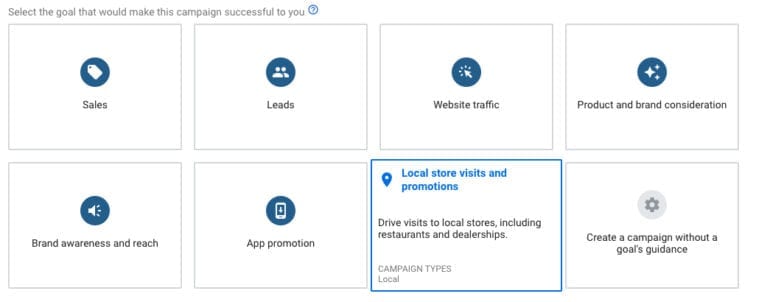Google Local Campaigns How-To

Looking for a way to drive customers through the front door? Welcome to the world of Google Local campaigns.
Designed to promote your businesses’ stores across Search, Maps, YouTube, and the Display Network, you simply add a few lines of text and let Google do the rest. This overview will include what requirements are needed before being able to run these campaigns and how to set up a campaign.
Basic Requirements:
It almost goes without saying but you’re going to need a storefront that accepts foot traffic. From there you’ll need to be able to track store visit conversions which does include some minimum requirements. According to Google:
- Have multiple physical store locations in eligible countries. Ask your account representative if store visit conversions are available in your location.
- Receive thousands of ad clicks and viewable impressions.
- Have a Google My Business account linked to your Google Ads account.
- Create each of your store locations in your Google My Business account.
- Have at least 90% of your linked locations verified in Google My Business.
- Ensure location extensions are active in your account.
- Have sufficient store visits data on the backend to attribute to ad click or viewable impressions traffic and pass our user privacy thresholds.
Google tracks store visits by utilizing a phone’s GPS history to match if someone visited your store after seeing an ad.
The next major step is ensuring you have your Google my Business locations or affiliate locations linked with Google Ads and accurate.
Once you’ve completed all the necessary steps, you should see the objective to drive Local traffic populate when you’re looking at creating a new campaign.
How to Build a Campaign:
This is a smart campaign so building a campaign is pretty easy. Our main levers are campaign budget and ad assets.
When you go to create your campaign, you’ll be greeted by the familiar goal screen. You’ll click on the local store visits and promotions option to start building.

You don’t have many levers to pull but you can opt into creating location groups. This is helpful if you have regional budgets or know that performance differs between areas. Think of this in a similar to product feed segmentation. Cluster like locations together but it’s not necessary or something you’d want to do for every single business.
In the next step, you set campaign budget, language targeting, and you do have the ability to show a product feed if you want to display physical inventory.
Finally, we are brought to the ad creation section. These are basic ads that Google manages and manipulates out to various networks. I recommend testing a wide variety of ideas beyond what you would in traditional search. You want to grab people’s attention and drive them to visit your store. That’s a much larger ask than clicking on your website!

These are simple ads as you can see. Images and videos are important so be sure to use imagery that is eye-catching. If someone is searching for pizza places by them, it never hurts to show a pizza ready to satiate their hunger!
From there, I encourage constant testing to ensure you’re continually driving more people to your stores. If you want even more granular data, adjust the in-store visit conversion action to be your average order value.
Possible Tests:
While limited in campaign creation, there are a number of tests you can run to continually nudge performance in a positive direction. Audience targeting is an easy first step. Break out people who have visited your website recently or test out in-market audiences.
Another great option would be testing the landing page on your website. If you’re a retail store, land people directly on a sales page. If you’re a restaurant, try the menu.
Driving in-store traffic doesn’t work for every business but it can be a valuable tool to ensure your brick and mortar store sees steady traffic.
Google Warns About Misuse of Its Indexing API

Google has updated its Indexing API documentation with a clear warning about spam detection and the possible consequences of misuse.
Warning Against API Misuse The new message in the guide says:
“All submissions through the Indexing API are checked for spam. Any misuse, like using multiple accounts or going over the usage limits, could lead to access being taken away.”
This warning is aimed at people trying to abuse the system by exceeding the API’s limits or breaking Google’s rules.
What Is the Indexing API? The Indexing API allows websites to tell Google when job posting or livestream video pages are added or removed. It helps websites with fast-changing content get their pages crawled and indexed quickly.
But it seems some users have been trying to abuse this by using multiple accounts to get more access.
Impact of the Update Google is now closely watching how people use the Indexing API. If someone breaks the rules, they might lose access to the tool, which could make it harder for them to keep their search results updated for time-sensitive content.
How To Stay Compliant To use the Indexing API properly, follow these rules:
- Don’t go over the usage limits, and if you need more, ask Google instead of using multiple accounts.
- Use the API only for job postings or livestream videos, and make sure your data is correct.
- Follow all of Google’s API guidelines and spam policies.
- Use sitemaps along with the API, not as a replacement.
Remember, the Indexing API isn’t a shortcut to faster indexing. Follow the rules to keep your access.
This Week in Search News: Simple and Easy-to-Read Update

Here’s what happened in the world of Google and search engines this week:
1. Google’s June 2024 Spam Update
Google finished rolling out its June 2024 spam update over a period of seven days. This update aims to reduce spammy content in search results.
2. Changes to Google Search Interface
Google has removed the continuous scroll feature for search results. Instead, it’s back to the old system of pages.
3. New Features and Tests
- Link Cards: Google is testing link cards at the top of AI-generated overviews.
- Health Overviews: There are more AI-generated health overviews showing up in search results.
- Local Panels: Google is testing AI overviews in local information panels.
4. Search Rankings and Quality
- Improving Rankings: Google said it can improve its search ranking system but will only do so on a large scale.
- Measuring Quality: Google’s Elizabeth Tucker shared how they measure search quality.
5. Advice for Content Creators
- Brand Names in Reviews: Google advises not to avoid mentioning brand names in review content.
- Fixing 404 Pages: Google explained when it’s important to fix 404 error pages.
6. New Search Features in Google Chrome
Google Chrome for mobile devices has added several new search features to enhance user experience.
7. New Tests and Features in Google Search
- Credit Card Widget: Google is testing a new widget for credit card information in search results.
- Sliding Search Results: When making a new search query, the results might slide to the right.
8. Bing’s New Feature
Bing is now using AI to write “People Also Ask” questions in search results.
9. Local Search Ranking Factors
Menu items and popular times might be factors that influence local search rankings on Google.
10. Google Ads Updates
- Query Matching and Brand Controls: Google Ads updated its query matching and brand controls, and advertisers are happy with these changes.
- Lead Credits: Google will automate lead credits for Local Service Ads. Google says this is a good change, but some advertisers are worried.
- tROAS Insights Box: Google Ads is testing a new insights box for tROAS (Target Return on Ad Spend) in Performance Max and Standard Shopping campaigns.
- WordPress Tag Code: There is a new conversion code for Google Ads on WordPress sites.
These updates highlight how Google and other search engines are continuously evolving to improve user experience and provide better advertising tools.
AI
Exploring the Evolution of Language Translation: A Comparative Analysis of AI Chatbots and Google Translate

According to an article on PCMag, while Google Translate makes translating sentences into over 100 languages easy, regular users acknowledge that there’s still room for improvement.
In theory, large language models (LLMs) such as ChatGPT are expected to bring about a new era in language translation. These models consume vast amounts of text-based training data and real-time feedback from users worldwide, enabling them to quickly learn to generate coherent, human-like sentences in a wide range of languages.
However, despite the anticipation that ChatGPT would revolutionize translation, previous experiences have shown that such expectations are often inaccurate, posing challenges for translation accuracy. To put these claims to the test, PCMag conducted a blind test, asking fluent speakers of eight non-English languages to evaluate the translation results from various AI services.
The test compared ChatGPT (both the free and paid versions) to Google Translate, as well as to other competing chatbots such as Microsoft Copilot and Google Gemini. The evaluation involved comparing the translation quality for two test paragraphs across different languages, including Polish, French, Korean, Spanish, Arabic, Tagalog, and Amharic.
In the first test conducted in June 2023, participants consistently favored AI chatbots over Google Translate. ChatGPT, Google Bard (now Gemini), and Microsoft Bing outperformed Google Translate, with ChatGPT receiving the highest praise. ChatGPT demonstrated superior performance in converting colloquialisms, while Google Translate often provided literal translations that lacked cultural nuance.
For instance, ChatGPT accurately translated colloquial expressions like “blow off steam,” whereas Google Translate produced more literal translations that failed to resonate across cultures. Participants appreciated ChatGPT’s ability to maintain consistent levels of formality and its consideration of gender options in translations.
The success of AI chatbots like ChatGPT can be attributed to reinforcement learning with human feedback (RLHF), which allows these models to learn from human preferences and produce culturally appropriate translations, particularly for non-native speakers. However, it’s essential to note that while AI chatbots outperformed Google Translate, they still had limitations and occasional inaccuracies.
In a subsequent test, PCMag evaluated different versions of ChatGPT, including the free and paid versions, as well as language-specific AI agents from OpenAI’s GPTStore. The paid version of ChatGPT, known as ChatGPT Plus, consistently delivered the best translations across various languages. However, Google Translate also showed improvement, performing surprisingly well compared to previous tests.
Overall, while ChatGPT Plus emerged as the preferred choice for translation, Google Translate demonstrated notable improvement, challenging the notion that AI chatbots are always superior to traditional translation tools.
Source: https://www.pcmag.com/articles/google-translate-vs-chatgpt-which-is-the-best-language-translator











